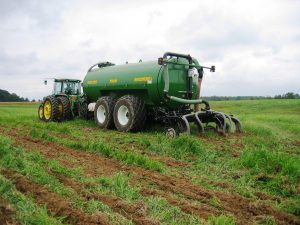R.F.D. NEWS & VIEWS
By Tim Alexander for Chronicle Media — April 26, 2017
Livestock manure reduces the amount of commercial fertilizer farmers apply to their crops. Farmers utilize manure management plans to balance the nutrients in the manure with the nutrient needs of the crop and the current nutrients in the soil providing a very sustainable system.
With Earth Day 2017 in our rearview mirror, testimony to Illinois farmers’ commitment to land, air and water stewardship continues to pour in. We’ve got the latest info on producers’ use of cover crops and other environmentally responsible conservation practices. Also, will above average temperatures persist across Illinois throughout the summer? For the answer, please read on …
Farmers: The ultimate recyclers
BLOOMINGTON — A lot of attention is rightly given to recycling household items such as cardboard, plastics, aluminum and paper on Earth Day. The Illinois Agricultural Coalition (IAC) wants consumers to know that farmers are some of the biggest recyclers in their communities. “Illinois livestock producers have been recycling for many generations by utilizing the nutrients in manure as an organic fertilizer source for their crops,” says Don Mackinson, president of the Illinois Milk Producers Association (IMPA) and a Pontiac dairy farmer.
Utilizing livestock manure as a crop nutrient reduces the amount of commercial fertilizers farmers apply to their crop fields. Producers develop nutrient management plans to balance the nutrients in manure with crop nutrient needs to achieve sustainability.
“Large and small farms alike have a responsibility to adopt management practices that protect our natural resources and limit any environmental impacts,” according to Mike Martz, a DeKalb farmer and president of the Illinois Beef Association (IBA). “Today’s livestock farms employ modern technology and innovations that allow us to better collect and recycle our valuable nutrients than we did just a generation ago.”
The IAC is comprised of the IMPA, IBA, Ill. Farm Bureau and Illinois Pork Producers Association. Farmers may contact any of the member association of the coalition to request a new resource guide detailing current Illinois EPA rules and best management practices for livestock operations.
“This is part of our ongoing joint efforts to help educate Illinois livestock farmers about these regulations,” explained Illinois Farm Bureau President and Ellis Grove farmer Richard Guebert Jr. “The resource guides are a great resource, and I urge all livestock farmers to get a copy.” (IAC news)
Illinois Farm Fact:
Results of the 2016 Cover Crop Survey conducted by the Sustainable Agriculture Research and Education program and the Conservation Technology Information Center show that after four years of cover crop usage, corn yield saw a bump of 8.3 bushels per acre and soybean yield increased by 2.4 bu./acre.
Cover seed dealers vary on Illinois preference
PEORIA — Another commitment to environmental stewardship demonstrated by Illinois farmers comes through the increasing use of cover crops to help stabilize and retain nutrients in soils, as reflected by recent surveys including a 2016 Cover Crop Survey Analysis conducted by the Sustainable Agriculture Research and Education (SARE) program. That survey showed acreage planted to cover crops continued its steady rise among survey participants.
But what are the most popular varieties of cover crops utilized by Illinois farmers? Two Illinois farmers who sell cover crop seed in adjoining regions of central and northwest Illinois I spoke with last week have differing opinions. A two-to-three variety mixture of cover crop seed is the most requested variety by customers of Brian Wieland, a Peoria County farmer who sells cover crop seed to farmers for Saddle Butte Ag.
“A mix of just a few complementary species seeded at the right time and rate can have tremendous benefits,” said Wieland. “A mixing of root types — taproots, fibrous roots, etc. — really improves soil tilth and water infiltration rates.”
Kewanee farmer and retired Extension educator Dean Oswald said farmers in his neck of the woods are contacting him for Cereal Rye seed in his new career as forage and grazing specialist for Midwest Grass and Forage. “Cereal Rye benefits include very deep rooting, which provides channels for deep cash crop rooting with improved air and water movement making the following crop more drought tolerant,” Oswald reported. “It can increase soil organic matter long term, and can be used for weed control when seeded at a higher rate. Even problem weeds like marestail and waterhemp can be reduced.”
Both experts agreed that cover crop interest and use continues to show yearly growth. “The guys that are doing it and have had some success can’t hardly do without it. They make it a priority as they see what it is doing to their soil,” said Wieland. “They are committed.”
Angel: Higher temps could prevail through fall
URBANA — Above-average temperatures experienced throughout Illinois in the first four months are expected to continue through May and beyond, reported Jim Angel, Illinois State Climatologist for the Illinois Water Survey, Prairie Research Institute, at the University of Illinois, in his weekly weather blog.
“Currently, the Pacific Ocean is in the neutral phase between La Nina and El Nino. There is much debate on if and when El Nino should return. It could happen in late summer,” said Angel. “Meanwhile, the theme running through the outlooks is the increased risk of above-average temperatures through the fall.”
Ten of 12 months during 2016 temperatures ran above average, as they have every month in 2017. During May 2017, eastern portions of Illinois are under an increased risk of being warmer than average, according to the National Weather Service.
“I am going out a little farther on a limb and say that all of Illinois has an increased chance of being warmer than average, based on recent trends and the climate models,” Angel said. “Meanwhile, most of Illinois and the the Great Lakes are expected to have an increased chance of below-average precipitation.”
–R.F.D. NEWS & VIEWS–



